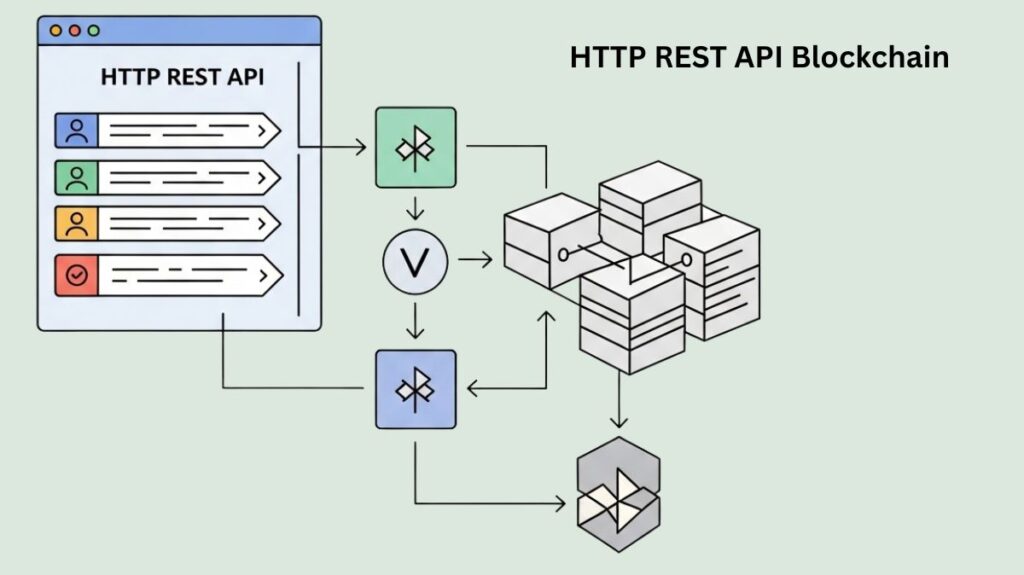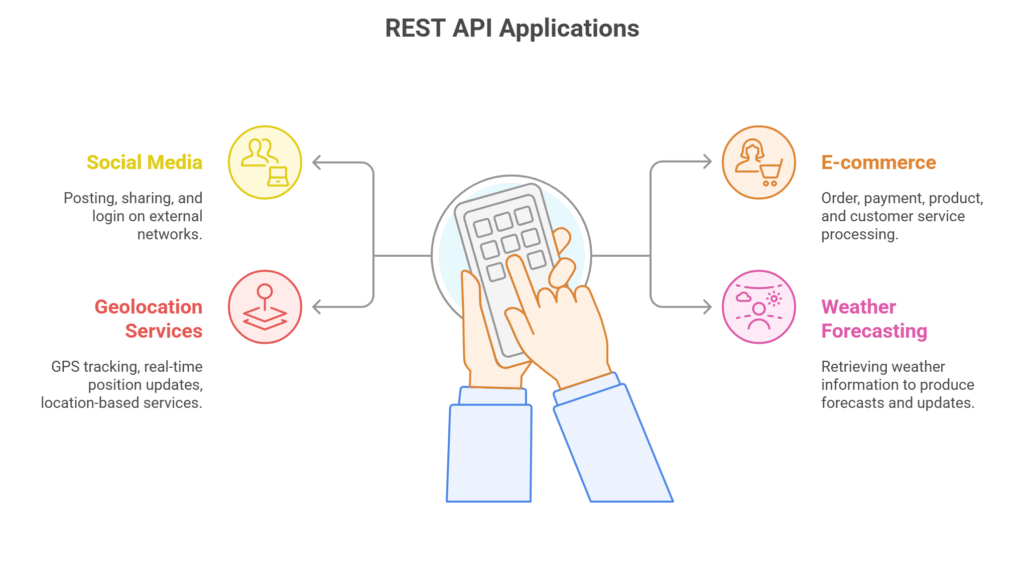HTTP REST API Blockchain

One popular architectural approach for creating networked applications is the HTTP REST API (Representational State Transfer Application Programming Interface). It functions as an interface within the blockchain, frequently for communicating with Ethereum nodes and services.
Fundamental Functions and Goals
- A straightforward HTTP-based interface for POSTing JSON messages is offered via the HTTP REST API.
- It enables programs to run server-side remote procedure calls. This implies that web apps or other clients can communicate with an Ethereum node in the context of the blockchain.
- It functions as a low-level interface via which clients can communicate with a node.
- Web3.js makes it simpler for web apps to communicate with blockchain services by abstracting away the underlying RPC calls, such as JSON-RPC, which can be sent via HTTP.
Connection to JSON-RPC
- JSON-RPC messages can be transported using the HTTP REST API. This implies that HTTP can be used to send JSON-RPC calls.
- For instance, the HTTP REST interface, which by default operates on the same TCP port (8332) as the JSON-RPC interface and doesn’t require authentication, is made available by the Bitcoin Core client starting with version 0.10.0.
- RPC calls to the Geth client can be made directly over HTTP, usually on TCP port 8545. Although Web3.js makes use of the JSON-RPC API, Web3.js is not required to make direct RPC calls.
Typical Tasks and Illustrations
Request Methods: JSON messages can be POSTed via the HTTP protocol. A popular command-line tool for interacting with REST APIs via HTTP POST requests is curl.
Examples of Enquiries
- The personal_listAccounts method is used to retrieve a list of accounts.
- Use the eth_coinbase method to query the Coinbase address.
- Getting access to public data, such as the market value of cryptocurrency pairs (e.g., BTC/USD).
- Enabling in Geth: Geth must be started with the –rpc flag in order to use the HTTP-RPC server, and you must use –rpcapi to indicate which APIs (such as eth, net, web3, personal, and debug) are available. The port can also be specified with –rpcport.
Utilisation and Integration in DApp Creation
Web3.js
This JavaScript module enables RPC connectivity, including HTTP, with an Ethereum node. It offers functions and classes for reliable blockchain communication.
MetaMask
By inserting a web3 object into webpages, this browser plugin serves as a Web3 provider. It then connects to the blockchain over RPC.
Etherscan
This centralised service provides a plain HTTP API that includes numerous JSON-RPC interface methods for querying blockchain data, as well as a web-based blockchain explorer.
External Trading APIs
Exchanges frequently offer developers access to APIs (which support REST and WebSockets) that enable the retrieval of ticker prices, order book information, account transaction history, and order execution. Usually operating on robust servers with quick network access, these APIs feature high rate restrictions to guard against misuse.
Also Read About Bitcoin API (Application Programming Interfaces) Functions
REST API Applications

To make system-to-system communication easier, REST APIs are widely employed in many different businesses. Typical uses include the following:
Social media
Including services like posting, sharing, and login on external networks like Facebook, Instagram, and Twitter.
E-commerce
E-commerce includes order processing, payment processing, product administration, and customer service.
Geolocation services
GPS tracking, real-time position updates, and location-based services like locating nearby locations are examples of geolocation services.
Weather Forecasting
Weather forecasting is the process of retrieving weather information from outside sources and using it to produce forecasts and updates in real time.
Also Read About What Is Proof of Authority, Advantages And Disadvantages
HTTP API Vs REST API
| Feature | HTTP API | REST API |
|---|---|---|
| Definition | A general communication protocol that uses HTTP to send requests and receive responses. | A specific type of HTTP API that follows REST architecture principles. |
| Protocol Used | HTTP | HTTP |
| Design Style | Not bound to any specific design style | Follows REST (Representational State Transfer) design principles |
| Structure | May not follow resources and verbs strictly | Uses standard HTTP methods like GET, POST, PUT, DELETE with URIs representing resources |
| Resource Identification | May not use resource-based URLs | Resources are identified via URIs (e.g., /block/123) |
| Statelessness | Optional (depends on implementation) | Must be stateless – no client context stored on server between requests |
| Cacheability | Not guaranteed | Responses are explicitly cacheable where appropriate |
| Use in Blockchain | Used for basic communication with blockchain nodes (e.g., sending raw transactions) | Used for accessing structured blockchain data like blocks, transactions, addresses |
| Flexibility | High flexibility, but less standardized | More standard and easier for developers to consume |
| Example in Blockchain | JSON-RPC over HTTP in Ethereum | RESTful APIs provided by platforms like BlockCypher or Etherscan |
| Error Handling | Custom or generic HTTP errors | Follows RESTful status codes (e.g., 200, 404, 500) |
Alos Read About REST API In PHP: HTTP Methods And Server Setup
Aspects of Security
The –rpccorsdomain flag must be properly configured when exposing the RPC endpoint, particularly on public networks. All remote connections are permitted when this flag is set to * (wildcard), which may result in security lapses if ETH or private keys are kept locally on the node.
It may be necessary to use HTTPS-encrypted communications, and certain nodes may need simple authentication.
